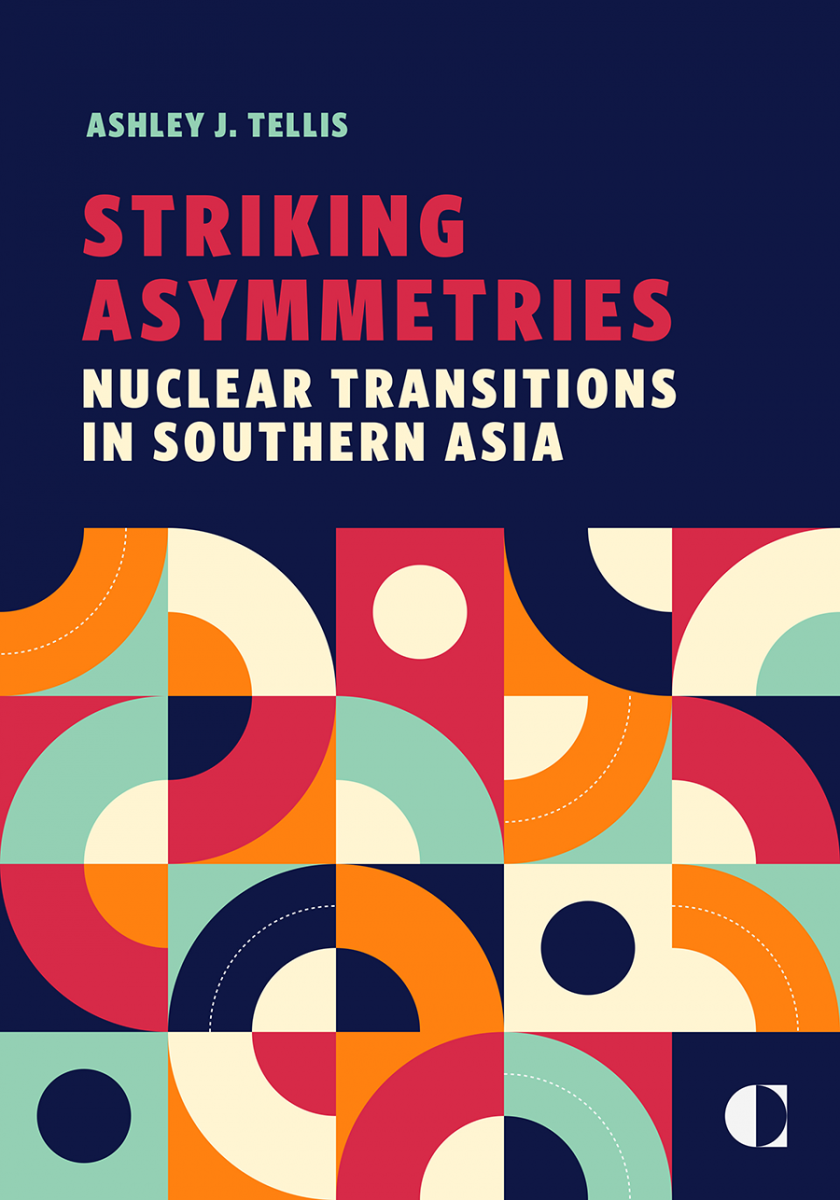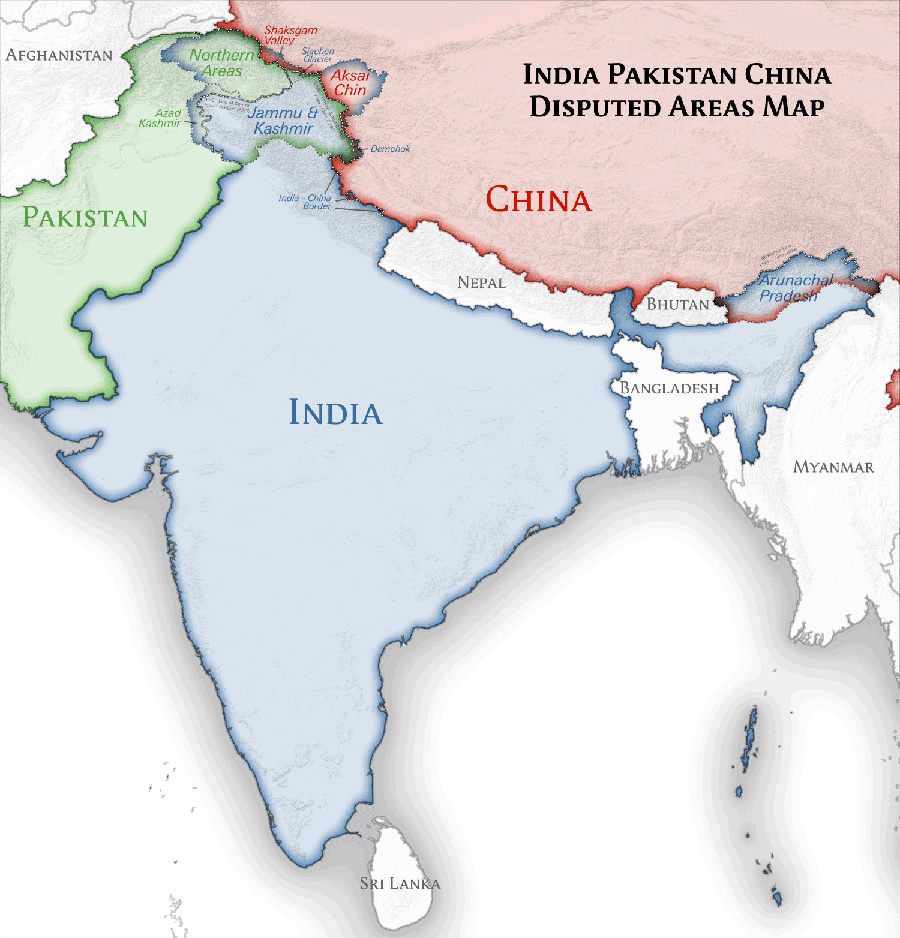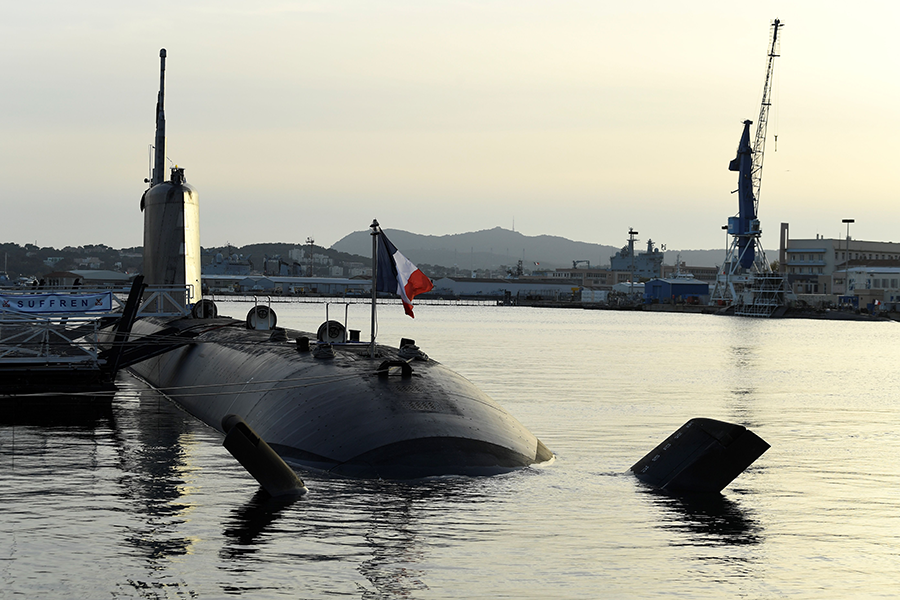"No one can solve this problem alone, but together we can change things for the better."
Striking Asymmetries: Nuclear Transitions in Southern Asia
March 2023
 Examining a Complex Nuclear Dynamic
Examining a Complex Nuclear Dynamic
Striking Asymmetries: Nuclear Transitions in Southern Asia
By Ashley J. Tellis
Carnegie Endowment for International Peace
2022
Reviewed by Manpreet Sethi
Southern Asia is a region with a complex nuclear dynamic. Three nuclear-armed states—China, India, and Pakistan—lie geographically next to each other. They suffer from long-standing territorial and ideological disputes. Each has its own thinking on how to establish nuclear deterrence. The buildup in capability by one of them, China, is directly linked to its threat perceptions of the United States, an extraregional power, although its responses impinge on others in the region. The countries form not just two adversarial dyads, but a nuclear chain where there is also perceived collusion between actors. Meanwhile, unlike the rough parity of Soviet and U.S. forces during the Cold War, the nuclear players in Southern Asia today are at disparate levels in terms of conventional, space, and cybercapabilities, as well as nuclear capabilities.
This complicated regional nuclear dynamic is challenging to understand and navigate. Yet, Striking Asymmetries by Ashley Tellis, a keen watcher of nuclear developments in Southern Asia, has managed to grasp and explain the nuclear intricacies of and between the three nuclear countries in the region. Given his long-standing scholarly eye on Asia, including a stint as senior adviser to the U.S. embassy in New Delhi and later as an adviser to the U.S. Department of State during negotiations on the Indian-U.S. nuclear deal, Tellis has a good perch from which to explain insightfully the ideational and material evolution of the Chinese, Indian, and Pakistani nuclear weapons programs since 1998.
True to expectation, the book is an erudite, systematic presentation of vast amounts of information. It undertakes an in-depth assessment of nuclear developments in each of the three countries over more than two decades. Following a uniform frame of analysis, the author patiently examines each country on the same three parameters: doctrine at declaratory and operational levels; material components, such as fissile material stockpiles, nuclear weapons designs and inventories, delivery systems, command and control arrangements and strategic defenses; and operational posture and force employment options. The first three chapters will be a go-to source for the vast literature that is laboriously mined and painstakingly listed in the 900-plus endnotes.
Exhaustive Scan
Tellis’ scan of the environment establishes that a qualitative and quantitative transformation in nuclear forces is underway in all three countries within the larger context of their difficult political interactions. Pakistan, sensing a disparity with India in conventional military power, views its nuclear capability as the equalizer. Nuclear weapons have assumed a centrality in Pakistan’s national security, serving as a shield for the country’s cross border terrorism provocations while averting the prospect of a conventional war with India. Pakistan projects an ability to handle escalation at each level by building capability that has evolved from the concept of credible minimum deterrence to full-spectrum deterrence.
Meanwhile, the U.S. ballistic missile defense program and its ability to use strategic missiles with conventional warheads provides the rationale for China to buttress its own deterrence by expanding its nuclear arsenal and improving its penetrability and survivability. These developments are expected to result in China attaining nuclear superiority over India.
In contrast to the flurry of nuclear activity in Pakistan and China, Tellis assesses that India is following a path of “strategic conservatism.” New Delhi has moved steadily to fulfill its decision to build a modest nuclear arsenal, despite a two-front nuclear threat. It maintains the arsenal at a relatively relaxed posture and is focused on developing and deploying elements that can ensure survivability. A no-first-use policy whose credibility comes from a commitment to assured retaliation has freed India from the need to develop large numbers of nuclear warheads and highly accurate nuclear delivery systems. India maintains that the benefit of nuclear weapons lies more in their possession than their use and hence has shown no desire for nuclear arms racing.
Strategic Stability in the Region
Notwithstanding the varying pace and nature of nuclear transformation in the region, Tellis finds that strategic stability is relatively robust in the two dyads. In the case of China and India, he attributes this to a common belief that nuclear weapons are useful for deterring nuclear attacks and coercion, not war-fighting. As a result, neither country has felt the need to revise its no-first-use doctrine, despite debates within their strategic communities, or to keep the weapons at high readiness levels. Even in conflict scenarios on the historically disputed border and territories, Tellis concludes that China and India have shown no proclivity to threaten nuclear use against each other or draw attention to their nuclear muscle.
By contrast, the Indian-Pakistani nuclear equation suffers from the risk of conventional war caused by Pakistan’s “continuing nuclear shadowed campaign of terrorism against India.” The crises caused by these terrorist attacks inevitably raise the possibility of escalation, although mutual vulnerability and reasonably robust second-strike capabilities offer a level of deterrence stability.
 Interestingly, Tellis finds that all three countries are inclined toward conservative operational postures based on their underlying belief in deterrence by punishment. Despite the buildup of some capabilities that can help China and Pakistan adopt a strategy of deterrence by denial, neither country has abandoned the conviction that the fundamental utility of nuclear weapons lies in deterring nuclear attacks. This “enduring element” is a significant factor contributing to strategic stability in the region.
Interestingly, Tellis finds that all three countries are inclined toward conservative operational postures based on their underlying belief in deterrence by punishment. Despite the buildup of some capabilities that can help China and Pakistan adopt a strategy of deterrence by denial, neither country has abandoned the conviction that the fundamental utility of nuclear weapons lies in deterring nuclear attacks. This “enduring element” is a significant factor contributing to strategic stability in the region.
Tellis, however, also identifies three potential developments that could upset regional strategic stability: the introduction of missile defenses that could interfere with the ability of nuclear weapons to cause unacceptable damage; the development of offense-driven counterforce capabilities that could target retaliatory nuclear forces, thereby increasing temptation for preemption; and the growth in transparency through developments in intelligence, surveillance, and reconnaissance (ISR) technology, data aggregation and analyses, and cyberintrusion.
Although these developments, individually or in combination, could threaten stability, the author’s prognosis underplays some features that are unique to the region. For instance, China and India have undertaken some missile defense efforts, but seem to have rejected the possibility of erecting national missile defense systems for their large landmasses. Point or area defenses have been considered for ensuring survivability of their arsenals or command and control systems. Mutual vulnerability, therefore, remains a consideration.
Further, with regard to nuclear counterforce and increasing transparency, none of these countries could launch a guaranteed nuclear first strike that would be sufficient to disarm the adversary. After all, the United States has not found it prudent to take that risk against North Korea despite having an overwhelmingly superior ISR capability, highly accurate missiles, and a nuclear arsenal estimated to be close to 100 times bigger than North Korea’s arsenal.
Another relevant factor in Southern Asia that has not been given due consideration in the book is geographic contiguity. The proximity of China, India and Pakistan means they cannot escape the effects of even a modest nuclear exchange. Therefore, a decision to use nuclear weapons will be affected by considerations other than those based only on availability of better counterforce or ISR capabilities. In fact, it can be argued that more than the deliberate use of nuclear weapons underwritten by improved capability, the region could stumble inadvertently into nuclear war because of some risk-prone strategies being pursued, ostensibly to enhance deterrence. For instance, China’s deployment of dual-capable missiles, including their commingling, and Pakistan’s signaling of an early use of tactical nuclear weapons are developments with a high potential for inadvertent escalation due to miscalculation.
Asymmetries in Understanding Deterrence
The main premise of Tellis’ book is that nuclear transitions in Southern Asia are creating striking asymmetries that, when juxtaposed with difficult political relations among the dyads and the overarching Chinese-U.S. competition, could pose new dilemmas. In the concluding chapter, Tellis focuses particularly on how the emergence of China as a “daunting strategic danger” might affect India on two specific issues and counsels the United States on how these could be leveraged to its benefit.
 The first issue is “India’s biggest nuclear deficiency,” which the author identifies as the “absence of reliable high-yield weapons in its inventory.” Based on data from India’s 1998 nuclear tests and subsequent assessments by scientists, he questions the weapons design base and argues that India does not have the “cutting-edge sophistication that would be needed for [weapons] reliability in real world conditions.” In order to validate advanced nuclear designs, Tellis believes India will feel the need to do a fresh round of testing and recommends that when this happens, the United States should not apply sanctions or suspend or terminate the Indian-U.S. nuclear deal. For the author, this would be “the best U.S. contribution toward enhancing geopolitical stability in the wider Asian region at a time when Chinese assertiveness will be increasingly harder to deter.” Given that China looms large on the U.S. threat radar, Tellis’ proposal is unsurprising, but it is not supported by any historical instance where the United States facilitated nuclear weaponization or testing even for its closest allies. It is doubtful that the suggestion will find traction with U.S. nonproliferation loyalists.
The first issue is “India’s biggest nuclear deficiency,” which the author identifies as the “absence of reliable high-yield weapons in its inventory.” Based on data from India’s 1998 nuclear tests and subsequent assessments by scientists, he questions the weapons design base and argues that India does not have the “cutting-edge sophistication that would be needed for [weapons] reliability in real world conditions.” In order to validate advanced nuclear designs, Tellis believes India will feel the need to do a fresh round of testing and recommends that when this happens, the United States should not apply sanctions or suspend or terminate the Indian-U.S. nuclear deal. For the author, this would be “the best U.S. contribution toward enhancing geopolitical stability in the wider Asian region at a time when Chinese assertiveness will be increasingly harder to deter.” Given that China looms large on the U.S. threat radar, Tellis’ proposal is unsurprising, but it is not supported by any historical instance where the United States facilitated nuclear weaponization or testing even for its closest allies. It is doubtful that the suggestion will find traction with U.S. nonproliferation loyalists.
Meanwhile, Tellis’ questioning of the credibility of India’s nuclear deterrence on the basis of the difference between atomic and thermonuclear weapons ignores basic Indian deterrence philosophy. The argument that only the threat of thermonuclear weapons could deter China because only megaton weapons can cause unacceptable damage to megacities tends to overlook the regional reality of high-density populations. A salvo of strategically dropped fission weapons will cause a degree of damage that no rational leader can find acceptable. Relatively sparsely populated Soviet and U.S. cities may have necessitated thermonuclear weapons to signal massive retaliation. Today, intelligent targeting can derive maximum damage potential from a nuclear weapon. Over the years, advances in real-time computational power, algorithmic sophistication, and data analysis have aided weapons improvements. Further, given India’s three decades of experience in fusion and plasma physics, it is unlikely that an adversary would want to risk checking out its thermonuclear weapons. Nuclear deterrence practiced through the idea of punishment fortunately is less demanding than the yardstick of denial strategies.
Tellis’ second recommendation involves helping India overcome the limitations of its sea-based deterrent so that it can put its weapons at sea to counter the growing vulnerability of its land forces to China’s highly accurate ballistic missiles. The author doubts India’s capability to develop a “powerful yet compact naval reactor” and a very quiet strategic nuclear submarine. He suggests that as with the Australia-UK-U.S. agreement that enabled the United States to reach out to an ally to balance their common adversary (China), a French-Indian-U.S. agreement could be crafted to help a friend (India) with the same objective. The transfer of French technology to India with regard to six conventional Scorpene submarines is already under way, but Tellis’ recommendation for the United States to “mid-wife” French nuclear propulsion technology seems somewhat unrealistic.
Whether there are takers for this idea in Washington or Paris or not, New Delhi would have its own set of reservations. In a global environment constrained by technology denials and export controls, India’s strategic nuclear submarine program has been based on a clear-headed approach of self-reliance in program management, platform design, and integration of diverse technologies with demonstrated levels of indigenization. This approach naturally gives the program the flexibility to progressively improve platform design and systems. The suggestion to establish another line of strategic platform production with its concomitant supply chain complexities at this juncture may not be an optimal solution for a country that has many demands on its fiscal resources.
The book performs yeoman’s service in comprehensively collating and analyzing nuclear evolution in Southern Asia. The author examines the nuclear landscape, highlights the transitions, and offers solutions for the future as he deems fit while keeping U.S. national interests in mind. Checkmating China is the primary U.S. national security concern in contemporary times, and Tellis offers some imaginative ideas. His suggestions, however, are unlikely to find widespread appeal in the U.S. nonproliferation community. Meanwhile, from an Indian perspective, they reflect a deterrence-by-denial approach to deterrence, which India has rejected.
In fact, if the nuclear players in Southern Asia continue to maintain their current common understanding that nuclear weapons are best suited for deterrence by punishment, they would be able to escape the trap of the war-fighting approach where credible deterrence demands demonstrated sophistication of warhead designs, increased reliable yields, counterforce accuracies, and damage limitation strategies. Nuclear transitions are inevitable with technological progression, but it looks likely that Southern Asia will adapt these advancements to its own understanding of deterrence and specific regional realities.
